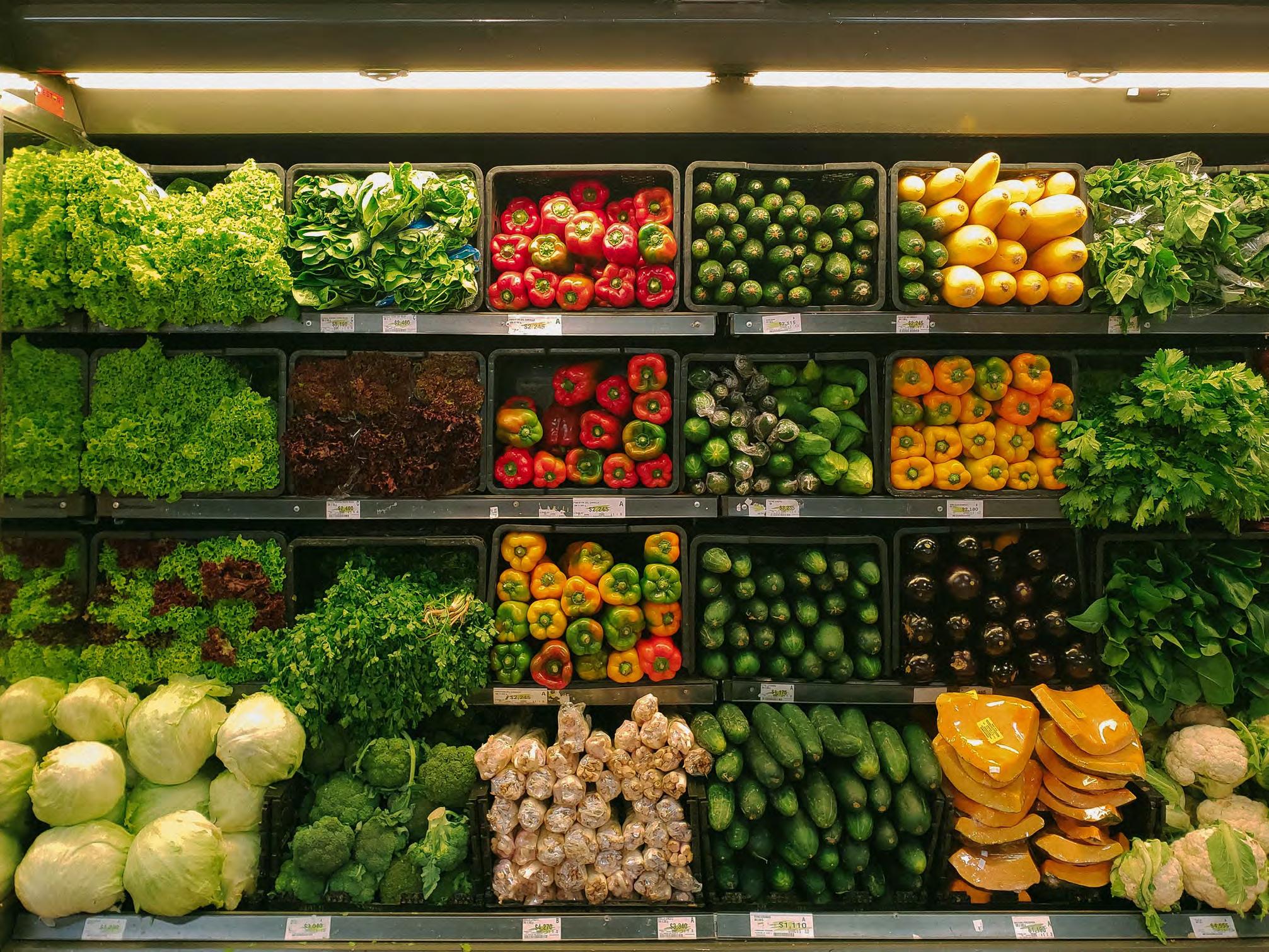
6 minute read
EATING OUR WAY
To Climate Resilience
6 Ways to Combat Climate Change with Food
Eat ClimateFriendly

The simplest way to increase climate-friendly purchasing is to buy more fruits, vegetables and other plant-based foods.
Waste Less
1/3 of all food produced is wasted and is responsible for 8% of worldwide GHG emissions. Eliminating food waste reduces this impact and address food insecurity.
Protect Soil






Safeguarding farmlands, promoting local, sustainable agriculture, and using climatefriendly practices boosts soil protection and carbon sequestration.

Eat Less & Better Meat
Meat has a high carbon footprint eating less helps. You can also choose lowerfootprint meats like chicken or fish.


Urban Agriculture
Urban farms, from community gardens to rooftop greenhouses, boost fresh food availability, fortify food system resilience, and promote urban sustainability.
Eat Local
Buying local food reduces "food miles", lowers fossil fuel usage and greenhouse gas emissions, preserves local lands, supports wildlife habitats, and encourages availability of fresh produce.

Strategy FA 1
Reduce food waste and hunger, achieve a 50% reduction in food insecurity Region -wide by 2030.
In the US, food waste is estimated at 30-40% of the supply. Based on State of Minnesota information, there is as much as 40-45,000 tons of annual food waste in the Region. This not only contributes to greenhouse gas emissions, but also results in an economic loss of over $50 million yearly, according to the nonprofit ReFed. Beyond economic implications, this wasted food could have helped needy families. As climate change threatens food security by disrupting production, limiting local availability, increasing prices, and reducing safety, food waste reduction becomes vital. It aligns with the region's Climate Action Plan Waste Management goals, enhances community sustainability, and could mitigate food insecurity.
Go to Implementation for supporting actions.
Strategy FA 2
Increase production of and access to local food, particularly serving food insecure and low income individuals.
The national US agricultural system, including specific regions, is susceptible to climate change impacts. Pacific states face challenges from dwindling water supplies, milder winters, and erratic spring weather. Grain production in the Great Plains and Midwest is at risk from fluctuating weather, warm winters, heatwaves, warm summer nights, and flooding. The production of beef, pork, and poultry in the Great Plains and Southeast is threatened by frequent and intense extreme weather and susceptible to disruptions in feed, water, and power supplies, which can occur with extreme weather events and other climate drivers.
While everyone may experience the effects of climate change on the food system, these impacts are likely to be more severe for those already facing low income or food insecurity. Boosting local food system capacity can enhance resilience, food security, job creation, and community wealth-building benefits.
Go to Implementation for supporting actions.
Protect and preserve agricultural land while increasing its resilience to climate shocks.
Local farms enhance food production and resilience, and agriculture along with forestry could contribute 20-30% of the required mitigation to restrict global warming to 1.5°C. Regrettably, climate impacts on farming have escalated over the past 40 years and are set to intensify, adding pressure on agricultural lands and their stewards. Concurrently, over 80 acres of US farmland are lost to development hourly. Preserving this land is key to fortifying the resilience of local food systems. Protecting and preserving the region’s agricultural land is an important component of supporting the resilience of local food systems.
Go to Implementation for supporting actions.
Strategy
FA 4
Increase share of farms using low emissions animal management practices achieving 75% adoption by 2030. (high feed efficiency and low emission manure management)
Adopting low-GHG animal management practices is essential for sustainability in farming. These practices not only minimize resource usage and methane emissions but also bolster animal well-being. For instance, precision livestock farming utilizes technology for optimal animal care, reducing emissions. Effective manure management, another example, helps control methane release. Lastly, integrating rotational grazing and dietary modifications for livestock can further diminish GHGs. Altogether, these practices combat climate change, fostering a more resilient, sustainable agriculture sector.
Go to Implementation for supporting actions.
Strategy
FA 5
Increase adoption of carbon positive soil and crop management practices, achieving 25% adoption by 2030.
Carbon-positive farming techniques, such as cover cropping, reduced tillage, and composting, are indispensable for agriculture. These practices store more carbon in the soil, enhancing its health, increasing crop productivity, and fostering biodiversity. By absorbing more CO2 than they release, they counteract climate change, supporting both the global carbon balance and farm sustainability. The proactive adoption of these carbon-positive practices is key for a resilient agricultural future.
Go to Implementation for supporting actions.
Strategy
FA 6
Increase use of anaerobic digestion, achieving 15% adoption by 2030.
Anaerobic digestion represents a significant opportunity to support climate action by transforming organic waste into bioenergy and fertilizer.. The process involves breaking down organic materials, like food waste or livestock manure, in an oxygen-free environment. The resultant biogas, a mix of methane and CO2, can be harnessed for heat or electricity, replacing fossil fuel usage and reducing our carbon footprint. Additionally, the process reduces methane emissions from decomposing waste a potent greenhouse gas thus mitigating climate change. The by-product, biofertilizer, can be used to improve soil health and fertility, further promoting sustainable agriculture. Therefore, anaerobic digestion serves dual climate action goals: it not only transforms waste into valuable resources but also contributes to a circular economy, reinforcing sustainable and resilient systems.
Go to Implementation for supporting actions.
What You Can Do
You can support the goals of the Local Food and Agriculture section of this climate action plan as an individual, household, or a business. Here are just a few things you can do:
1. Rent a plot at your local community gardens and grow your own.
2. Eat a plant-rich diet. Animal products are extremely GHGintensive to produce compared to plants. Eating less meat and dairy will reduce emissions associated with food consumption. Eating regionally-grown food that is suitable for the Minnesota climate will also make a difference through reduced transportation-related emissions. A great place to start is with “Meatless Mondays” or one meat-free meal a day.
3. Buy food directly from a local grower on an ongoing basis by joining a Community Sponsored Agriculture (CSA) group or frequenting the farmer’s market.
4. Plant fruit or nut bearing trees or shrubs that are well suited for our hardiness zone on your property. Examples include: Trees: Apple, Pear, Plum, Black walnut, Shrub: Serviceberry, Currant.
5. Support restaurants and grocery stores that use and sell locally-grown food.

6. Buy food that is in season, minimizing the distance food must travel.
7. Support your local farmers markets.
8. Buy ethically grown and harvested food, like fair-trade coffee and chocolate.







Trees and natural ground coverings are instrumental in bolstering regional health, enhancing air and water quality, cutting down energy usage in buildings, and contributing to climate mitigation. Recent research indicates that even simple interactions with nature, like visiting a park or observing a tree, can substantially boost a person's health and reduce stress levels. Consequently, our appreciation of trees has broadened to include their significant mental and physical health benefits. In terms of environmental advantages, trees play an indispensable role in purifying air by extracting harmful pollutants, such as Carbon Monoxide, particulate matter, and Ground -level Ozone. These contaminants can reach toxic levels and trigger asthma and other respiratory issues.
Prairie Grass and Climate Action

Replacing traditional turf lawns with prairie grass and wildflowers serves as an effective climate adaptation strategy. These native species require less water and maintenance, reducing irrigation needs and carbon emissions from lawn care equipment. Their deep root systems improve soil health, enhance water absorption, and increase carbon sequestration, mitigating flood risk and contributing to climate change mitigation. Additionally, they provide habitats for local wildlife, promoting biodiversity. This transformation supports the ecosystem, reduces environmental impact, and fosters resilience against changing climate conditions, making it a sustainable, multifaceted approach to climate adaptation.
The Link Between Impervious Surfaces and Extreme Heat
Impervious surfaces like pavements and buildings in a region contribute to higher "heat island" effects, resulting in increased atmospheric and surface temperatures in developed areas compared to rural ones. This rise in temperature, particularly during summer, heightens discomfort and health risks, especially during heat waves. A 2006 study by Minnesota State University and the University of Minnesota elucidated a ratio illustrating the correlation between a region's impervious surface percentage and the corresponding heat island temperature increase.
Equity Considerations
Lower-income and diverse areas often have less tree canopy coverage, which results in missed benefits such as environmental enhancement, economic gains, and improved quality-of-life. These neighborhoods also suffer disproportionately from the urban heat island effect, characterized by higher temperatures due to fewer trees and more heat-absorbing surfaces like pavements and buildings. Consequently, residents experience increased heat, discomfort, and health risks, further compounding environmental inequalities.
Equity Approach Examples:
1. Targeted tree-planting initiatives in these neighborhoods.
2. Community-led programs for pavement-to-garden and turf-to-prairie conversions to promote local involvement.
3. Policy-driven incentives for green roof installations on buildings, aiming to reduce temperature disparities and enhance residents' well-being.
(831,200 acres by 2040)
Strategies
The strategies on the following pages guide our path in meeting our climate goals for the Greenspace and Trees sector. Each strategy is supported by a series of detailed actions to be explored and undertaken in order to carry out the vision and goals. These supporting actions are outlined in the Implementation section of this plan.
Go to Implementation for supporting actions.






